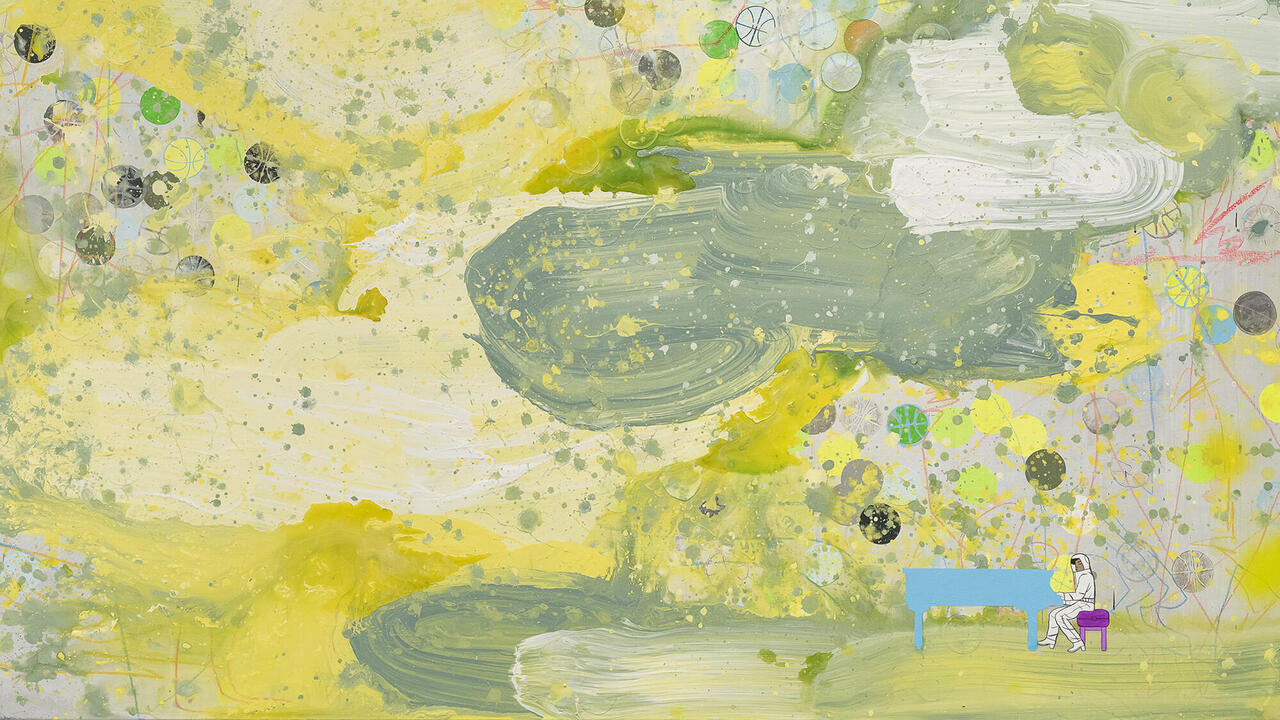A.L. Steiner & robbinschilds
If that venerable American tradition the cross-country road trip is just another way of repeating an endless compulsion to go west, further despoiling the landscape in the process, the hypnotic 11-minute digital video C.L.U.E. (color location ultimate experience) Part I (2007) offers an alter-native. In this bravura collaboration between the photographer, filmmaker and Chicks on Speed member A.L. Steiner and robbinschilds, the two-woman dance team of Sonya Robbins and Layla Childs, robbinschilds dances across the country, celebrating the natural terrain as though embodying the treasured Woody Guthrie folk song ‘This Land Is Your Land’ (1940), while also engaging the denatured, the ravaged and the man-made. Apart from ecstatically strewing ‘memos’ from nearby office buildings or losing a stray shoe on a desert highway, they leave their surroundings untouched.
C.L.U.E.’s journey begins at the primordial, with robbinschilds wriggling out of the sea in unison. They leap, skip and jump through the DIY megastore Home Depot, the gleaming government plaza of New York State’s capital in Albany, suburban lawns and swimming pools, redwood forests, salt flats and river basins. In calmer moments they sit on rocky outcrops, nestle in a bulldozer’s shovel or slowly bend and turn inside a junkyard van. As if in a euphoric dream of endless transformation, they wear crayon-bright costumes and accessories in seven hues approximating to the wavelengths of the visual spectrum – scarlet or hot pink, orange, yellow, green, aqua, indigo and violet – plus the white that results when they are combined. With each change of scenery and clothing they enter a new colour band, emotional state and realm of possibility.
Their relationship deepens as C.L.U.E. progresses: after beginning their journey almost as one, pressed shoulder to shoulder, they quickly start to help or influence one another. (Accom-panying photographs reveal even more, as in a
shot of the two in a forest, tied together with a cloth that blindfolds one dancer.) Eventually, wearing white, they perform a dreamy pas de deux in a shopping centre car park after dark while passers-by walk backwards. At the conclusion they wrestle under the magnificent alien-looking roots of a fallen redwood.
Steiner was largely responsible for the filmmaking, but the project feels like a seamless collaboration. The three women have known each other for years, and their comfortable working relationship seemed to play a role in the satisfying symbiosis between dancing, costumes and cinematic technique. Since founding their troupe in 2003, robbinschilds have probed the relationship between movement and architecture (sites for their performances have ranged from a skate park to a rug-strewn set mimicking a hotel ballroom), but their exploration is as playful as it is rigorous – and insistently visual. They’ve suggested that the fanciful consistency of their preoccupations, noting ‘a particular attraction to empty spaces, public places, geological formations, time travel and psychedelic filigree’.
Dance’s relationship with installation and objects gets robbinschilds as fired up as its intersection with architecture and landscape. Early in the show’s run they presented a live performance in the confined upstairs space where the video was projected – its intimate scale contrasts dramatically with the wide-open vistas in C.L.U.E. Five hours long, the performance was an intense durational experience. Without staying perfectly synchronized with their projected selves, the pair made choreographed movements similar to those in the video. At times they struck spaced-out poses on the floor; throughout, they made quick-fire costume changes. Finally they stripped down and crawled naked from the exhibition area into the office. Afterwards the costumes remained on view in a large, colour-coded pile like a collapsed rainbow – or one of the geological formations in the video – with white garments off to one side.
The knock-out, moodily propulsive soundtrack, by the Seattle-based post-psychedelic rockers Kinski, is so integral as to suggest that the work might be viewed as a new breed of music video. The changing locations, rapid cutting and infectious energy recall punchy MTV videos of yore in which singers danced in front of shifting backdrops. But given the unity between C.L.U.E.’s striking visuals and robbinschilds’ obsessive, almost ritualistic, movements and poses, the comparison is a facile one – this trio is up to something much more curious. That something may or may not open up new possibilities for interaction between visual art and dance, but the video does a good job of persuading you that it will. Meanwhile, plans for C.L.U.E. Part II include a performance to be held in New York in the autumn as an evening-length work with installation, video and live accompaniment by Kinski, so this trip isn’t over yet.
















